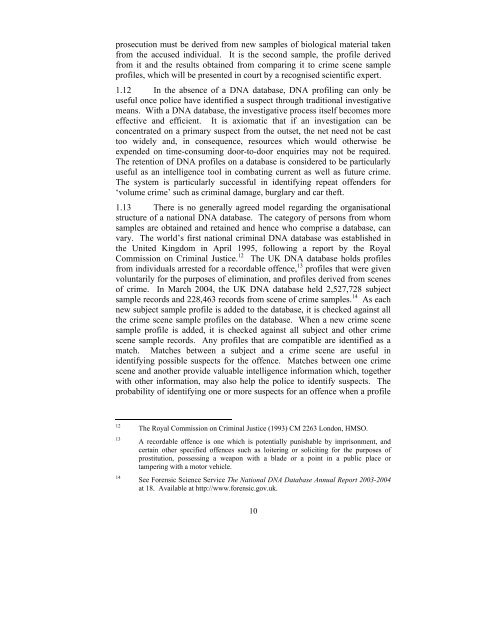Establishment of a DNA Database - Law Reform Commission
Establishment of a DNA Database - Law Reform Commission
Establishment of a DNA Database - Law Reform Commission
Create successful ePaper yourself
Turn your PDF publications into a flip-book with our unique Google optimized e-Paper software.
prosecution must be derived from new samples <strong>of</strong> biological material takenfrom the accused individual. It is the second sample, the pr<strong>of</strong>ile derivedfrom it and the results obtained from comparing it to crime scene samplepr<strong>of</strong>iles, which will be presented in court by a recognised scientific expert.1.12 In the absence <strong>of</strong> a <strong>DNA</strong> database, <strong>DNA</strong> pr<strong>of</strong>iling can only beuseful once police have identified a suspect through traditional investigativemeans. With a <strong>DNA</strong> database, the investigative process itself becomes moreeffective and efficient. It is axiomatic that if an investigation can beconcentrated on a primary suspect from the outset, the net need not be casttoo widely and, in consequence, resources which would otherwise beexpended on time-consuming door-to-door enquiries may not be required.The retention <strong>of</strong> <strong>DNA</strong> pr<strong>of</strong>iles on a database is considered to be particularlyuseful as an intelligence tool in combating current as well as future crime.The system is particularly successful in identifying repeat <strong>of</strong>fenders for‘volume crime’ such as criminal damage, burglary and car theft.1.13 There is no generally agreed model regarding the organisationalstructure <strong>of</strong> a national <strong>DNA</strong> database. The category <strong>of</strong> persons from whomsamples are obtained and retained and hence who comprise a database, canvary. The world’s first national criminal <strong>DNA</strong> database was established inthe United Kingdom in April 1995, following a report by the Royal<strong>Commission</strong> on Criminal Justice. 12 The UK <strong>DNA</strong> database holds pr<strong>of</strong>ilesfrom individuals arrested for a recordable <strong>of</strong>fence, 13 pr<strong>of</strong>iles that were givenvoluntarily for the purposes <strong>of</strong> elimination, and pr<strong>of</strong>iles derived from scenes<strong>of</strong> crime. In March 2004, the UK <strong>DNA</strong> database held 2,527,728 subjectsample records and 228,463 records from scene <strong>of</strong> crime samples. 14 As eachnew subject sample pr<strong>of</strong>ile is added to the database, it is checked against allthe crime scene sample pr<strong>of</strong>iles on the database. When a new crime scenesample pr<strong>of</strong>ile is added, it is checked against all subject and other crimescene sample records. Any pr<strong>of</strong>iles that are compatible are identified as amatch. Matches between a subject and a crime scene are useful inidentifying possible suspects for the <strong>of</strong>fence. Matches between one crimescene and another provide valuable intelligence information which, togetherwith other information, may also help the police to identify suspects. Theprobability <strong>of</strong> identifying one or more suspects for an <strong>of</strong>fence when a pr<strong>of</strong>ile121314The Royal <strong>Commission</strong> on Criminal Justice (1993) CM 2263 London, HMSO.A recordable <strong>of</strong>fence is one which is potentially punishable by imprisonment, andcertain other specified <strong>of</strong>fences such as loitering or soliciting for the purposes <strong>of</strong>prostitution, possessing a weapon with a blade or a point in a public place ortampering with a motor vehicle.See Forensic Science Service The National <strong>DNA</strong> <strong>Database</strong> Annual Report 2003-2004at 18. Available at http://www.forensic.gov.uk.10
















